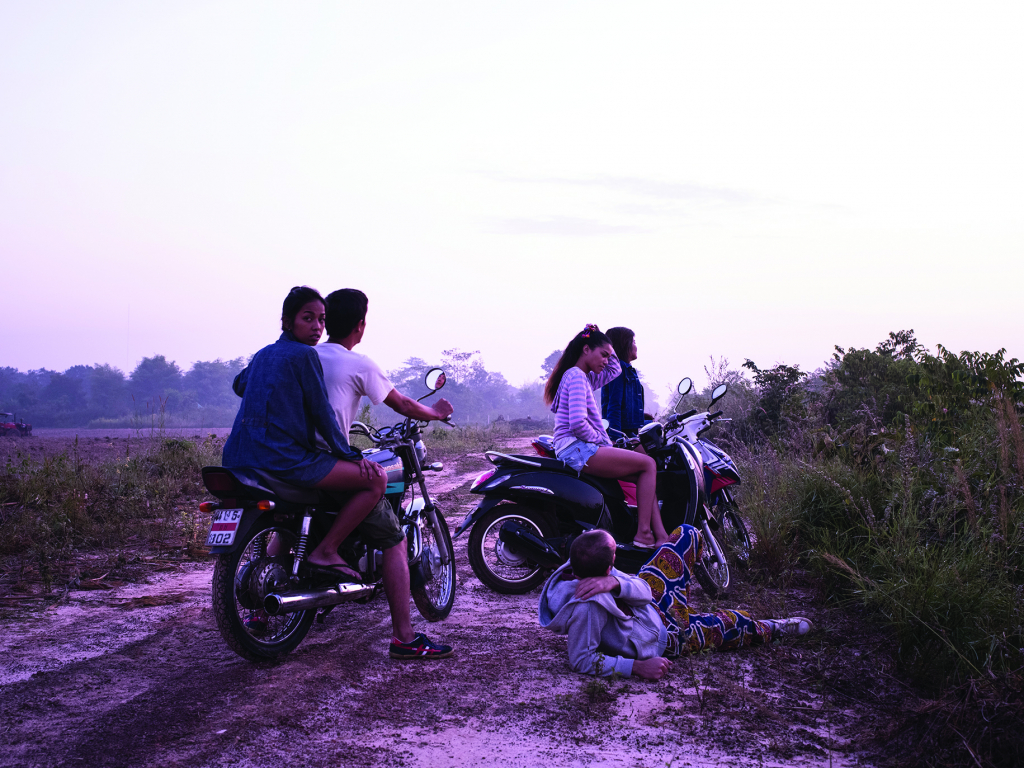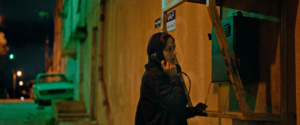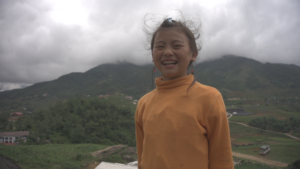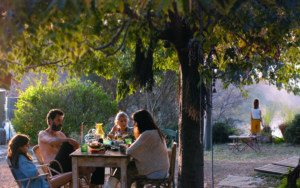What is the meaning of paradise?
‘Paradise’ is a word with the power to conjure up images of tropical islands shimmering in the sun, of snowfields dusted with untouched powder, of pristine rainforests populated with exotic animals. It’s a word imbued with a sense of the Other, a touch of unfamiliarity; paradise might not be far from our front door, but it’s never in our backyard. Paradise is an escape. An idyll. A place for tourists, for those stepping outside their own day-to-day experiences.
In Katsuya Tomita’s Bangkok Nites (2016), paradise is specifically located in Thailand’s thriving hub of sex tourism. The film spends much of its time in and around Bangkok’s Thaniya Road, a red-light district populated by Thai sex workers and the Japanese men they cater for. As one of those men explains: ‘Each year, 1.5 million Japanese visit Thailand. More than any other country!’ This statistic is offered as a boast to the women draped across him in one of Thaniya’s brothels, where the women’s fluency in Japanese determines their ability to earn for their families back home. For these men, Thaniya Road is paradise.
Over the course of three hours, Tomita and screenwriter Toranosuke Aizawa investigate the notion of paradise, branching out from Thaniya Road to explore questions regarding capitalism and colonialism across South-East Asia. While the film’s opening is shot from within the Bangkok studio apartment of Luck (Subenja Pongkorn), the ‘number-one’ girl at her brothel, Bangkok Nites is framed much like a tourist experiencing an unfamiliar country: beginning at its showy yet seedy centre, then circling outwards to explore its regional districts and, along the way, gradually coming to understand the nation’s history of violence and exploitation.

He fills his head with culture
The Hollywood Reporter’s review of Tomita’s earlier film Saudade (2011) observes that it ‘spins on for nearly three long hours with no attempt at synthesis, allowing what little dramatic structure there is to emerge casually’.[1]Deborah Young, ‘Saudade: Film Review’, The Hollywood Reporter, 25 March 2012, <http://www.hollywoodreporter.com/review/saudade-film-review-304035>, accessed 19 May 2017. That description could be applied without modification to Bangkok Nites, which, despite following a linear progression, displays little interest in setting up anything approaching a conventional dramatic narrative.
While Tomita is content to idly migrate from scene to scene and character to character, he nonetheless establishes two characters on which to focus. The first is Luck, who has been both enriched and ruined by her extensive experience as a sex worker. The second, played by Tomita himself, is Ozawa. A client of Luck’s from five years prior, Ozawa strikes up a relationship of sorts with his former lover after a chance encounter. Their respective fortunes have reversed – Ozawa is barely scraping by, while Luck boasts about buying her mum a house and her dog a ¥700,000[2]Roughly A$8000. diamond-studded collar – which lends their pairing an ambiguous power imbalance.
Ozawa’s primary role within the film is to act as both a stand-in for the director and an audience surrogate throughout our exploration of the intersection of Thai and Japanese history. Ozawa and Tomita are both tourists within Thailand. Tomita’s fascination with Thailand as a paradise for Japanese tourists is clear from his earlier movies: Saudade and Off Highway 20 (2007) include the line ‘Thailand is paradise’, yet the latter was made before the director had ever ‘set foot out of Japan’.[3]Katsuya Tomita, quoted in Kuzoku Inc., Bangkok Nites press kit, 2016, p. 4. Ozawa’s path towards a deeper understanding of Thailand mirrors Tomita’s own journeys through the country.
Not that all of Thailand’s Japanese visitors demonstrate such readiness to expand their comprehension of Thai culture. Most display little compunction in leveraging the economic disparity between the two countries for cheap sex. And drugs – one male Japanese character marvels at how cheap ice costs there compared to its street price in Japan: ‘Isn’t Thailand great? It’s like a utopia!’ Yet the screenplay resists establishing a simplistic dichotomy; in many respects, these tourists are victims of exploitative capitalism in their own way. We’re even privy to a meeting with condominium developers who plan to dupe elderly Japanese men into buying condos ‘with a wife attached!’
While Bangkok Nites is upfront that tourists might be taken for a ride, it’s nonetheless made clear that the costs of the Thai sex-work industry are borne almost entirely by the sex workers. That’s especially apparent in the revelations of the third act, in which we learn that Luck has contracted HIV. Nor are the Japanese tourists entirely blameless; many are downright detestable. Perhaps the most egregious example is a tourist who, late in the film, brags about ‘go[ing] to the countryside and try[ing] girls for free before they come to Bangkok’.

This whole world was countryside
The countryside – from Nong Khai, in the north-eastern Isaan provinces of Thailand, through to Laos – is the setting of the bulk of the film’s middle hour. It’s through this section of the film that Tomita offers his most full-throated deconstruction of the Japanese notion of paradise. The choice to set much of the film in Isaan was inspired by Tomita’s own research of Thai brothels, as he discusses in an interview for 4:3:
When we ha[d] the idea to shoot this film, Bangkok Nites, we were of course focused on night time night life in Bangkok. But as we started talking to the women working in these districts, we came to realise that, what was said? Eighty percent? Close to eighty percent of these women are from the Isaan province? They come to the city to do some work […] The path that they’ve traveled is one from Isaan to Bangkok, but we decided to go against the tide.[4]Katsuya Tomita, quoted in Jeremy Elphick, ‘Bangkok Nites – An Interview with Katsuya Tomita’, 4:3, 23 August 2016, <http://fourthreefilm.com/2016/08/bangkok-nites-an-interview-with-katsuya-tomita/>, accessed 19 May 2017.
When Ozawa and Luck first arrive in Nong Khai to visit Luck’s family, the pastoral setting seems serene compared to the neon-lit hustle of Bangkok. ‘Clean air / no need for an air conditioner’ goes the soundtrack[5]Aizawa notes that the music choices were deeply tied to the Isaan region, explaining, ‘Much of this music includes gestures of protest and means of resistance. But what’s essential is [that] it isn’t an ideology but an element which is viscerally ingrained in the people’s culture’; see Kuzoku Inc., op. cit., p. 6. as aerial shots highlight the tropical beauty of the Thai countryside. Ozawa meets Luck’s family, gets stoned, goes for a walk – it’s all quite lovely. But it’s not long before the film is unpicking the idealised depiction of the country as an unspoiled paradise. We enter the area as tourists but, like any tourists staying in an area for an extended period, the murkier characteristics of the region soon become apparent. Visits to the local ‘Smile Bar’ reveal a smaller-scale sex industry – except, here, the tourists are predominantly white rather than Japanese.
One of those tourists, a Frenchman who appears to be perpetually drunk, initially seems invested in the history of the region, offering uninvited history lessons about how communists were slaughtered during the 1980s resistance. ‘If you think about it,’ he spits, ‘there is really something rotten in this fucking paradise.’ We quickly come to understand, though, that he’s more likely complaining about having to pay his local lover (‘Is there anything you don’t have to pay for in Thailand?’) than offering an authentic reflection on the area’s violent past.
Bangkok Nites doesn’t shy away from this history of violence, but it’s rarely addressed directly. Instead, we’re encouraged to reflect on how the area is shaped by cratered scars on its landscape, how Ozawa’s experience with the Japan Self-Defense Forces affects his own self-doubt, and how Luck’s half-brother’s life is shaped by his parentage as the son of an American soldier. That parentage gets precious little screen time, but feels integral to the interweaving of colonialism, capitalism and violence in shaping Thai history.[6]And beyond Thailand. The screenplay makes it clear, for instance, that the relationship of Laos to Thailand is much like that of Thailand to Japan, with many of the sex workers in the Thai provinces hailing from Laos. The prevailing sense – more emotional than explicit – is one of a wounded country, limping towards a future that seems unobtainable. (It doesn’t seem accidental that one of the film’s final scenes is of Ozawa buying a gun, even if the precise purpose of the purchase remains ambiguous.)
Those societal wounds are disproportionately visited on Thai women who – if Bangkok Nites’ implications are to be believed – are destined for poverty or sex work, with scant options in between. Certainly, this is the reality within Luck’s family, as she bitterly explains in the film’s final minutes:
Women in our family, we’ve always been poor. Aunts raising mothers, and mothers turning tricks to raise their kids. That’s how mothers meet fathers. Us women in the family are happy until we turn sixteen. Then we move to Bangkok.

Seen a ghost
The opening minutes of Bangkok Nites are defined by low-grade digital photography, night scenes and expressive editing. It feels distinctly modern, as though we’re watching a spin on classics of Japanese geisha cinema – think: Kenji Mizoguchi’s The Life of Oharu (1952) or Mikio Naruse’s When a Woman Ascends the Stairs (1960) – updated with contemporary aesthetics. In fact, an early line from Luck (‘Japanese men always promise marriage. The liars!’) could double as a synopsis for the latter film, in a pinch. As Bangkok Nites progresses, the style gets somewhat more sedate than in these opening scenes, yet it retains a distinctly ‘indie’ energy.
When the setting shifts to Nong Khai, the aesthetics and tone adjust accordingly. An experimental approach bleeds into the until-then relatively conventional style, most prominently when a family dinner dissolves into foggy slow motion. The middle third of the film feels particularly indebted to the style of Thai filmmaker Apichatpong Weerasethakul. It’s not simply the way Bangkok Nites assumes a syrupy, somnolent feel, but also the way Tomita incorporates a sense of the spiritual. A nocturnal encounter between Ozawa and a ghost (or so we’re led to believe, anyway) unfolds with the kind of ordinary nonchalance with which Weerasethakul depicts the supernatural in Uncle Boonmee Who Can Recall His Past Lives (2010) and Cemetery of Splendour (2015).
This could come across as appropriative – after all, this is a Japanese director aping the style of one of Thailand’s best-known auteurs – but it doesn’t play that way.[7]For me, at least – though, as an Australian-born white critic, I’m hardly an authority on the matter. Partly, this is because of Tomita’s clear respect for the region and the effort he’s clearly spent stripping away his own touristic naivety. But, mostly, I suspect it’s because Tomita actually collaborated with Weerasethakul during pre-production, meeting with him before filming began.[8]Kuzoku Inc., op. cit., p. 5. Bangkok Nites feels inspired by and indebted to the Thai director’s work – fitting, given the prominence of the Isaan region in Weerasethakul’s filmmaking.
Tomita balances the tone somewhat less successfully in the film’s final hour, which switches back and forth between Bangkok, and Laos and Isaan, as Ozawa and Luck temporarily part ways. The naturalistic tone is, I’d argue, slightly lessened by the inclusion of non-professional actors. Pongkorn, despite intuitively embodying the physicality and look of Luck, often comes across as stilted and practised in her line readings. The three-hour running time is perhaps a liability here, too; while the film’s first two thirds are largely successful in interrogating the fundamental corruption beneath Thailand’s ‘paradise’, the ideas it posits are articulated clearly enough that the final hour can’t help but feel rather repetitive in parts.
That vague feeling of dissatisfaction, while surely unintentional, feels quite appropriate in context. It suits the tenor of a film that takes you to somewhere exotic and enticing, and then, step by step, pulls it apart. That reveals the mechanics and bloody history underneath the cheap entertainment, comprehensively souring the tourist experience. These are the things we try to disregard as travellers, the things we skim over in our guidebooks. How else could we cling onto the idea of paradise?
Endnotes
| 1 | Deborah Young, ‘Saudade: Film Review’, The Hollywood Reporter, 25 March 2012, <http://www.hollywoodreporter.com/review/saudade-film-review-304035>, accessed 19 May 2017. |
|---|---|
| 2 | Roughly A$8000. |
| 3 | Katsuya Tomita, quoted in Kuzoku Inc., Bangkok Nites press kit, 2016, p. 4. |
| 4 | Katsuya Tomita, quoted in Jeremy Elphick, ‘Bangkok Nites – An Interview with Katsuya Tomita’, 4:3, 23 August 2016, <http://fourthreefilm.com/2016/08/bangkok-nites-an-interview-with-katsuya-tomita/>, accessed 19 May 2017. |
| 5 | Aizawa notes that the music choices were deeply tied to the Isaan region, explaining, ‘Much of this music includes gestures of protest and means of resistance. But what’s essential is [that] it isn’t an ideology but an element which is viscerally ingrained in the people’s culture’; see Kuzoku Inc., op. cit., p. 6. |
| 6 | And beyond Thailand. The screenplay makes it clear, for instance, that the relationship of Laos to Thailand is much like that of Thailand to Japan, with many of the sex workers in the Thai provinces hailing from Laos. |
| 7 | For me, at least – though, as an Australian-born white critic, I’m hardly an authority on the matter. |
| 8 | Kuzoku Inc., op. cit., p. 5. |





